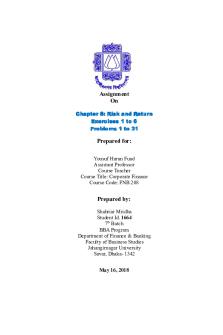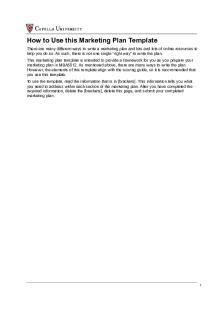CF Note - CF statement PDF

| Title | CF Note - CF statement |
|---|---|
| Author | Bless Godino |
| Course | Financial Reporting and Finance |
| Institution | University of Liverpool |
| Pages | 3 |
| File Size | 266.1 KB |
| File Type | |
| Total Downloads | 88 |
| Total Views | 166 |
Summary
CF statement...
Description
Estimating After-Tax After-Tax After Incremental Cash Flows Principles that must be adhered to in the estimation
12-10
Ignore sunk costs
Include opportunity costs
Include project-driven changes in working capital net of spontaneous changes in current liabilities
Include effects of inflation
MACRS Sample Schedule Recovery Year 1 2 3 4 5 6 7 8
Initial cash outflow -- the initial net cash investment. Interim incremental net cash flows -those net cash flows occurring after the initial cash investment but not including the final period’s cash flow. TerminalTerminal- year incremental net cash flows -- the final period’s net cash flow.
12-18
Property Class 5-Year 20.00% 32.00 19.20 11.52 11.52 5.76
7-Year 14.29% 24.49 17.49 12.49 8.93 8.92 8.93 4.46
12-13
Calculating the Incremental Cash Flows
3-Year 33.33% 44.45 14.81 7.41
Initial Cash Outflow a) b) c)
Cost new” assets Cost of of “new” + Capitalized expenditures + (-) Increased (decreased) NWC
d)
-
e) f)
Net proceeds from sale of “old” asset(s) if replacement + (-) Taxes (savings) due to the sale of “old” asset(s) if replacement == Initial cash outflow outflow
12-19
Terminal-Year Terminal Incremental Cash Flows
Incremental Cash Flows a)
a)
b)
Net incr. (decr.) in operating revenue less (plus) any net incr. (decr.) in operating expenses, excluding depr. - (+) Net incr. (decr.) in tax depreciation
c) d)
= Net change in income before taxes - (+) Net incr. (decr.) in taxes
c)
- (+) Taxes (tax savings) due to asset sale or disposal of “new” assets
d)
e)
=
f) g)
+ (-) Net incr. (decr.) in tax depr. charges = Incremental net cash flow for period
+ (-) Decreased (increased) level of “net” working capital = Terminal year incremental net cash flow
b)
Net change in income after taxes e)
Calculate the incremental incremental net net cash cash flow for the terminal terminal period period + (-) Salvage value (disposal/reclamation costs) of any sold or disposed assets
12-20
Example of an Asset Expansion Project Basket Wonders (BW) is considering the purchase of a new basket weaving machine. The machine will cost $50,000 plus $20,000 for shipping and installation and falls under the 3year MACRS class. NWC will rise by $5,000. Lisa Miller forecasts that revenues will increase by $110,000 for each of the next 4 years and will then be sold (scrapped) for $10,000 at the end of the fourth year, when the project ends. Operating costs will rise by $70,000 for each of the next four years. BW is in the 40% tax bracket.
12-22
Initial Initial Cash Cash Outflow Outflow a) b) c) d)
$50,000 20,000 5,000 0 (not a replacement)
+ + -
e) f)
+ (-) 0 (not a replacement) = $75,000* * Note that we have calculated this value as a “positive” because it is a cash OUTFLOW (negative).
12-23
Terminal-Year TerminalIncremental Cash Flows
Incremental Incremental Cash Cash Flows Flows Year 1
Year 2
Year 3
Year 4
$40,000 31,115 $ 8,885
$40,000 10,367 $29,633
$40,000 5,187 $34,813
a) b) c)
=
$40,000 23,331 $16,669
d) e)
=
6,668 $10,001
3,554 $ 5,331
11,853 $17,780
13,925 $20,888
f) g)
+ =
23,331 $33,332
31,115 $36,446
10,367 $28,147
5,187 $26,075
a)
$26,075 $26,075
b)
+
10,000
c)
-
4,000
d)
+
5,000
e)
=
$37,075
12-25
The incremental cash flow from the previous slide in Year 4. Salvage Value. .40*($10,000 - 0) Note, the asset is fully depreciated at the end of Year 4. NWC - Project ends. Terminalyear incremental Terminal-year cash flow.
12-24
Example Example of of an an Asset Asset Replacement Project
Initial Cash Outflow
Let us assume that previous asset expansion project is actually an asset replacement project. The original basis of the machine was $30,000 and depreciated using straight-line over five years ($6,000 per year). The machine has two years of depreciation and four years of useful life remaining. BW can sell the current machine for $6,000. The new machine will not increase revenues (remain at $110,000) but it decreases operating expenses by $10,000 per year (old = $80,000). NWC will rise to $10,000 from $5,000 (old).
a) b)
+
c) d) e)
+ -
f)
=
$50,000 20,000 5,000 6,000 (sale of “old” asset) 2,400...
Similar Free PDFs

CF Note - CF statement
- 3 Pages

CF Case
- 10 Pages

Kelloggs cf
- 47 Pages

RS14 - bronchiectasis and CF
- 4 Pages

Recommendation-CF - Good
- 5 Pages

MCQ - 204 - FM & CF
- 50 Pages

CS6004 CF ND19 Rejinpaul
- 1 Pages

CF Legislação Destacada
- 124 Pages

Dornase Alfa (CF ATI) - Copy
- 1 Pages

Actividad 1 CA y CF
- 5 Pages

Bai tap- CF- 2018- solution
- 10 Pages

Slides CF 2019 - Part 1
- 93 Pages
Popular Institutions
- Tinajero National High School - Annex
- Politeknik Caltex Riau
- Yokohama City University
- SGT University
- University of Al-Qadisiyah
- Divine Word College of Vigan
- Techniek College Rotterdam
- Universidade de Santiago
- Universiti Teknologi MARA Cawangan Johor Kampus Pasir Gudang
- Poltekkes Kemenkes Yogyakarta
- Baguio City National High School
- Colegio san marcos
- preparatoria uno
- Centro de Bachillerato Tecnológico Industrial y de Servicios No. 107
- Dalian Maritime University
- Quang Trung Secondary School
- Colegio Tecnológico en Informática
- Corporación Regional de Educación Superior
- Grupo CEDVA
- Dar Al Uloom University
- Centro de Estudios Preuniversitarios de la Universidad Nacional de Ingeniería
- 上智大学
- Aakash International School, Nuna Majara
- San Felipe Neri Catholic School
- Kang Chiao International School - New Taipei City
- Misamis Occidental National High School
- Institución Educativa Escuela Normal Juan Ladrilleros
- Kolehiyo ng Pantukan
- Batanes State College
- Instituto Continental
- Sekolah Menengah Kejuruan Kesehatan Kaltara (Tarakan)
- Colegio de La Inmaculada Concepcion - Cebu



